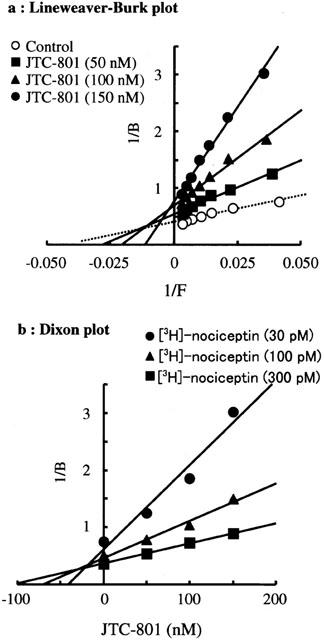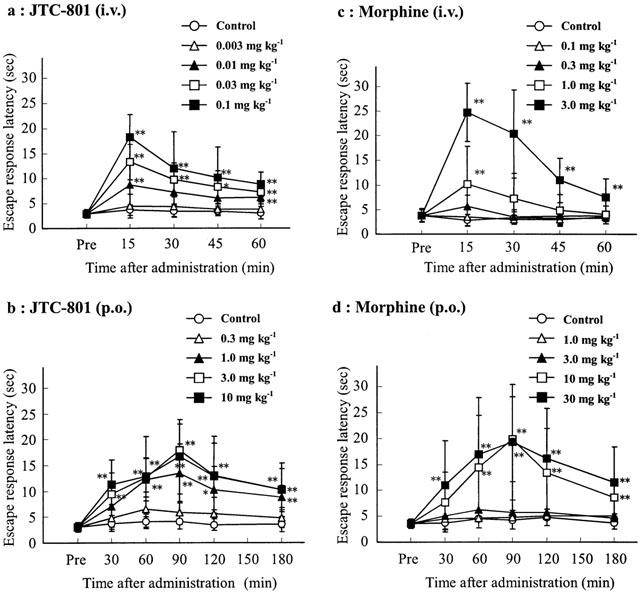
| Size | Price | Stock | Qty |
|---|---|---|---|
| 10mg |
|
||
| 25mg |
|
||
| 50mg |
|
||
| 100mg |
|
||
| 250mg |
|
||
| 500mg |
|
||
| Other Sizes |
|
Purity: ≥98%
JTC-801 HCl (JTC 801; JTC801), the hydrochloride salt of JTC801, is a potent, orally bioactive and selective opioid receptor-like1 (ORL1) receptor antagonist with potential analgesic activity. It blocks opioid receptor-like1 (ORL1) with an IC50 of 94 nM.
| Targets |
NOP Receptor/ORL1
|
|
|---|---|---|
| ln Vitro |
|
|
| ln Vivo |
|
|
| Enzyme Assay |
Membranes from human μ-opioid receptor-expressing CHO-K1 cells suspended in 50 mM Tris-HCl buffer (pH 7.4) with 10% sucrose, 5 mM MgCl2, and 0.33 nM 2H-labeled diprenorphine are incubated for 2.5 hours at room temperature with different concentrations of JTC-801. Whatman 934-AH is used to filter the membranes, and a TopCount A9912V scintillation counter is used to count radioactivity. 10 μM naloxone is used to measure nonspecific binding (6.4%). By deducting nonspecific binding from total binding, specific binding is computed. The mean±SE (n=3) is the data.
|
|
| Animal Protocol |
|
|
| References |
| Molecular Formula |
C26H26CLN3O2
|
|
|---|---|---|
| Molecular Weight |
447.96
|
|
| Exact Mass |
447.171
|
|
| Elemental Analysis |
C, 69.71; H, 5.85; Cl, 7.91; N, 9.38; O, 7.14
|
|
| CAS # |
244218-51-7
|
|
| Related CAS # |
|
|
| PubChem CID |
5311339
|
|
| Appearance |
White to off-white solid powder
|
|
| Boiling Point |
580.9ºC at 760mmHg
|
|
| Melting Point |
235℃
|
|
| Flash Point |
305.1ºC
|
|
| Vapour Pressure |
1.73E-13mmHg at 25°C
|
|
| LogP |
6.975
|
|
| Hydrogen Bond Donor Count |
3
|
|
| Hydrogen Bond Acceptor Count |
4
|
|
| Rotatable Bond Count |
6
|
|
| Heavy Atom Count |
32
|
|
| Complexity |
577
|
|
| Defined Atom Stereocenter Count |
0
|
|
| SMILES |
Cl[H].O(C1C([H])=C([H])C(=C([H])C=1[H])C([H])([H])C([H])([H])[H])C([H])([H])C1=C([H])C([H])=C([H])C([H])=C1C(N([H])C1C([H])=C([H])C2C(=C(C([H])=C(C([H])([H])[H])N=2)N([H])[H])C=1[H])=O
|
|
| InChi Key |
NQLIYKXNAXKMBL-UHFFFAOYSA-N
|
|
| InChi Code |
InChI=1S/C26H25N3O2.ClH/c1-3-18-8-11-21(12-9-18)31-16-19-6-4-5-7-22(19)26(30)29-20-10-13-25-23(15-20)24(27)14-17(2)28-25;/h4-15H,3,16H2,1-2H3,(H2,27,28)(H,29,30);1H
|
|
| Chemical Name |
N-(4-amino-2-methylquinolin-6-yl)-2-[(4-ethylphenoxy)methyl]benzamide;hydrochloride
|
|
| Synonyms |
|
|
| HS Tariff Code |
2934.99.9001
|
|
| Storage |
Powder -20°C 3 years 4°C 2 years In solvent -80°C 6 months -20°C 1 month Note: Please store this product in a sealed and protected environment, avoid exposure to moisture. |
|
| Shipping Condition |
Room temperature (This product is stable at ambient temperature for a few days during ordinary shipping and time spent in Customs)
|
| Solubility (In Vitro) |
|
|||
|---|---|---|---|---|
| Solubility (In Vivo) |
Solubility in Formulation 1: ≥ 2.5 mg/mL (5.58 mM) (saturation unknown) in 10% DMSO + 40% PEG300 + 5% Tween80 + 45% Saline (add these co-solvents sequentially from left to right, and one by one), clear solution.
For example, if 1 mL of working solution is to be prepared, you can add 100 μL of 25.0 mg/mL clear DMSO stock solution to 400 μL PEG300 and mix evenly; then add 50 μL Tween-80 to the above solution and mix evenly; then add 450 μL normal saline to adjust the volume to 1 mL. Preparation of saline: Dissolve 0.9 g of sodium chloride in 100 mL ddH₂ O to obtain a clear solution. Solubility in Formulation 2: ≥ 2.5 mg/mL (5.58 mM) (saturation unknown) in 10% DMSO + 90% (20% SBE-β-CD in Saline) (add these co-solvents sequentially from left to right, and one by one), clear solution. For example, if 1 mL of working solution is to be prepared, you can add 100 μL of 25.0 mg/mL clear DMSO stock solution to 900 μL of 20% SBE-β-CD physiological saline solution and mix evenly. Preparation of 20% SBE-β-CD in Saline (4°C,1 week): Dissolve 2 g SBE-β-CD in 10 mL saline to obtain a clear solution. View More
Solubility in Formulation 3: ≥ 2.5 mg/mL (5.58 mM) (saturation unknown) in 10% DMSO + 90% Corn Oil (add these co-solvents sequentially from left to right, and one by one), clear solution. Solubility in Formulation 4: 0.5% methylcellulose: 30 mg/mL |
| Preparing Stock Solutions | 1 mg | 5 mg | 10 mg | |
| 1 mM | 2.2323 mL | 11.1617 mL | 22.3234 mL | |
| 5 mM | 0.4465 mL | 2.2323 mL | 4.4647 mL | |
| 10 mM | 0.2232 mL | 1.1162 mL | 2.2323 mL |
*Note: Please select an appropriate solvent for the preparation of stock solution based on your experiment needs. For most products, DMSO can be used for preparing stock solutions (e.g. 5 mM, 10 mM, or 20 mM concentration); some products with high aqueous solubility may be dissolved in water directly. Solubility information is available at the above Solubility Data section. Once the stock solution is prepared, aliquot it to routine usage volumes and store at -20°C or -80°C. Avoid repeated freeze and thaw cycles.
Calculation results
Working concentration: mg/mL;
Method for preparing DMSO stock solution: mg drug pre-dissolved in μL DMSO (stock solution concentration mg/mL). Please contact us first if the concentration exceeds the DMSO solubility of the batch of drug.
Method for preparing in vivo formulation::Take μL DMSO stock solution, next add μL PEG300, mix and clarify, next addμL Tween 80, mix and clarify, next add μL ddH2O,mix and clarify.
(1) Please be sure that the solution is clear before the addition of next solvent. Dissolution methods like vortex, ultrasound or warming and heat may be used to aid dissolving.
(2) Be sure to add the solvent(s) in order.
|
|---|
 |
 |